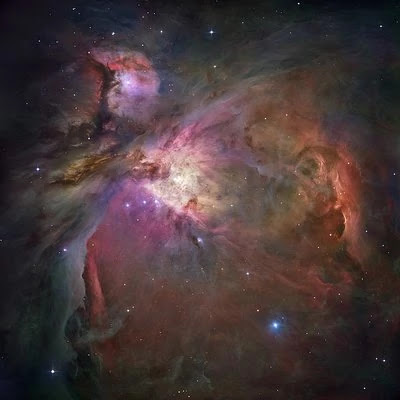Discoveries of Hubble space telescope | Iconic images from Hubble space telescope | Hubble discoveries Part-1
(Note: Before reading this article, go through our last
article about Hubble space telescope. So that you can understand this article
easily, click here to open.)
The Hubble space telescope captured many iconic images since
its launch on 24 April, 1990. It captured images starting from celestial
objects in our solar system to very distant galaxies in the Observable
Universe.
Since 1993, NASA is integrating the advanced instruments in
the Hubble space telescope to collect data and capture high resolution images.
This helps the scientists to understand the science behind them more
accurately.
Let's look at some of the iconic images from Hubble space
telescope.
Pillars of creation:
 |
| Pillars_of_Creation_Into_the_dark_space Image credit: NASA, Jeff Hester, and Paul Scowen (Arizona State University) |
Pillars of creation is an image taken by the Hubble space
telescope on 1 April, 1995. It is a region of elephant trunks of interstellar
gas and dust in Eagle Nebula located in Serpens constellation at a distance of
7000 light years away from the Earth.
Crab Nebula:
 |
| Crab_Nebula_Into_the_dark_space Image credit: NASA, ESA, J. Hester and A. Loll (Arizona State University) |
Crab Nebula is a supernova remnant of a star located in the
Taurus constellation at a distance of 6500 light years away from the Earth. It
corresponds to the SN 1054 supernova, filed by ancient astronomers in 1054 AD.
The image of Crab Nebula was assembled from 24 individual
exposures by Hubble (Wide Field Planetary Camera 2), taken in October 1999,
January and December of 2000. This is the largest image of a supernova remnant ever
taken by Hubble and the highest resolution image ever made of entire Nebula.
A neutron star called 'Crab Pulsar' which is 30 kms across,
lies at the centre of the Crab Nebula. This pulsar spins at a rate of 30 times
per second and pulses radiation in between high energy gamma rays to radio
waves.
NGC 1015:
 |
| NGC_1015_Into_the_dark_space Image credit: ESA/Hubble & NASA, A. Riess (STScl/JHU) |
NGC 1015 is a barred spiral galaxy like our Milky way
galaxy. It is located at a distance of 118 million light years away from the
Earth in the constellation of Cetus (The Whale).
The circles seen in the image are the cepheid variable stars
and brighter spots are the supernovae occurring in the NGC 1015 galaxy. NGC
1015 was observed by Hubble's Wide Field Camera 3 in 2013.
The Orion Nebula:
 |
| Orion_Nebula_Into_the_dark_space Image credit: NASA, ESA, M. Robberto (Space Telescope Science Institute/ESA) and the Hubble Space Telescope Orion Treasury Project Team |
Orion Nebula is a region of interstellar gas and dust
located at a distance of 1300 light years away from the Earth in the
constellation of Orion.
It is also known as M42 or NGC 1976. It is one of brightest
nebulae in the night sky, which is visible to our naked eye. Orion Nebula is
the nearest star formation area to Earth, in which thousands of stars are being
born. It is estimated that the Orion Nebula is 24 light years across and 2000
times more massive than the Sun.
This image consists of more than 3000 stars in various
stages in their lives. The brighter spot at the centre consists of four massive
stars in the Nebula.
GN-z11 galaxy:
GN-z11 galaxy is the most distant, oldest and highest red
shifted known galaxy in the Observable Universe, located at a staggering
distance of 32 billion light years away from the Earth in the constellation of
Ursa Major.
This galaxy is identified by the Hubble's Wide Field Camera
3. It is estimated that the light reaching us from the GN-z11 is of 13.4
billion years old meaning 400 million years after big bang. So, the light we
are observing from GN-z11 galaxy is from the ending of the 'Dark ages of the
Universe' and beginning of 're-ionzation era'.
Share your ideas and thoughts in comment section below.
For more information click here and for updates please follow my site,
Thank you.

Choosing of topics is very gud and interesting
ReplyDeleteThank you, keep supporting and share.
DeleteWow
ReplyDeleteThank you.
DeleteVery Interesting
ReplyDeleteThank you, share.
DeleteNice
ReplyDeleteThank you.
DeleteGood and interesting
ReplyDeleteThank you, keep sharing.
DeleteSubject was quite innovative and it was vivid
ReplyDeleteThank you, keep supporting and share.
DeleteExcellent work... intersting topic
ReplyDeleteThank you, keep sharing.
DeleteGood work.....interesting
ReplyDeleteThe topic is really good.... And everyone need to know about it, the creation.. Good work....!!! #keepgoing #helixnebula
ReplyDeleteThank you for your support. The article on other discoveries will be posted soon, to get it follow and subscribe. Stay tuned.
Deleteimpressive. ��
ReplyDeleteNice topic very interesting
ReplyDeleteThank you, do follow and subscribe.
DeleteNice
ReplyDeleteGood
ReplyDeleteThank you.
DeleteGood topics, interesting 😍.
ReplyDeleteThank you, do follow and subscribe for more articles.
DeleteInteresting!!!
ReplyDeleteThank you, share.
DeleteInteresting
ReplyDeleteThank you.
DeleteInteresting
ReplyDeleteThank you.
DeleteGood information 👌👌
ReplyDeleteThank you, keep sharing.
DeleteIntersting and good work done
ReplyDeleteThank you.
DeleteInteresting facts..!
ReplyDeleteBest way to explore the things.
Grabs the intension.
Waiting for the next content.....
Thanks for your support. Trying our best to give you the best content, stay tuned. For more information, do follow and subscribe.
DeleteThank you. Hubble's Wide Field Camera 3 (WFC3) was installed as replacement for Wide Field and Planetary Camera 2 on Hubble's servicing mission 4 on 14 may, 2009. It is the Hubble's advanced instrument, which is used to capture images in between UV, visible and near infrared spectrum of light. It can capture wide range of wavelength of light at a large field of view. Since 2009, WFC3 helping us to capture high resolution images of the celestial objects in the Observable Universe.
ReplyDeleteFore more information about Hubble space telescope, once read this article: https://bit.ly/2VBVxHu
Thank you.
ReplyDeletesuperb bro
ReplyDeleteThank you bro.
DeleteSuperb topics & intresting
ReplyDeleteThank you. share.
DeleteNice and interesting
ReplyDeleteThank you.
DeleteReally nice.....superb
ReplyDeleteThank you. Keep supporting.
Delete